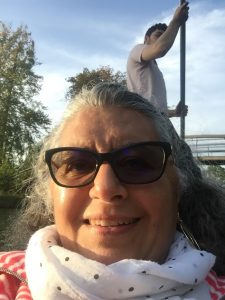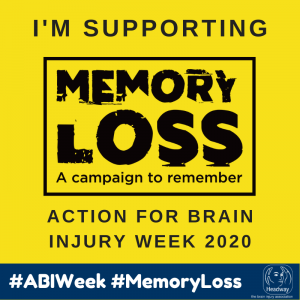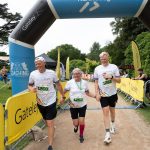Action for Brain Injury Week this year  is focusing on memory loss after acquired brain injury.
is focusing on memory loss after acquired brain injury.
After Anita had two operations on her brain to remove two tumours, she faced many obstacles as a result of the surgery’s impact on her memory. Here, she explores how she copes with this challenge.
Picture the scene: Friday night in
“Let’s watch a movie”
“Ok ideas?”
“Not sure but something light-hearted”
“Give me a minute as I check out the hot choices over the last few years”
“Ok I’ll grab a tea. Fancy a cuppa?”
“I’m ok, I’ll stick to a Friday night beer”
“Here’s a flick with a high IMDb rating… here we go…”
“Hmmm …Open credits look good. What’s it called?”
“Spy, released in 2015”
“Cool …Hey, Jude Law playing a camio James Bond… hang on this looks familiar…have I seen this before? Give me a minute let’s see how much I can remember…”
“You sure or should we find another movie anyway?”
“Give it a minute … let me see if I can remember the storyline”
5 minutes later…
“Hang on, I don’t recall this movie. That’s strange… I remember the first few scenes with Jude Law in his black tie and his suave moves but after that it’s a blank?? Let’s just watch it as it looks good.”
My thoughts
…So where did I watch this? With whom? Why didn’t I watch the whole movie? Just like Linkee the game, what is the common factor here??? My memory or should I say lack of it? Does this happen to you? Does this ring any bells for you? Does it make you want to pull your hair out and scream in private?
My memory story

I was unfortunate enough to have two brain tumours. On the other hand, I was incredibly lucky to have two ops to remove as much of the tumours as possible. I’m now on a journey of discovery as I learn to re-engage my brain in normal everyday activities. The two main hurdles I have encountered are fatigue and memory failure. To explain to people who ask how I am, I take the allergy (that doesn’t sound right… come on, what’s the word I’m looking for?) of comparing myself to a barometer.
Like every human being, my body uses heaps of energy to function everyday. I reckon on a good day my fuel tank runs on 30% capacity. One of the biggest drains on my energy is memory retrieval. Following on from my ops when it comes to recalling something short term or long term I struggle. I find it especially difficult to recall facts and figures. I guess this relates to damaged memory traces and broken encoding.
I can literally feel my brain disappearing as it searches for information I previously knew, or thought I knew. While I wait for it to surface I grab myself a mental cup of coffee and cake, patiently waiting for the answer to bounce into my consciousness.
Does this annoy me? Yes! Do I suffer from brain fog? Yes! Does my brain hurt when I try really hard in a quiz? Yes!
What’s my personal solution? Keep on trying and don’t give up.
I have noticed there are slight improvements in my retrieval capabilities especially by adopting a number of varied strategies.
State of mind: My number one strategy is being in a happy state of mind (this doesn’t involve CBT). I get better results when it comes to my memory functions as I’m not having to push the negative thoughts to one side before I start the recall process. Removing unnecessary complications gives my memory a better opportunity to utilise my limited energy resources. I have been told my brain is now adapting to the new space in my head, I visualise this as a seedling growing into a flower that needs to be nurtured and nourished in a kind manner to encourage it to blossom with colour.
In medical terms this is referred to the plasticity of the brain. As you can imagine the brain is now forced to adapt into a new environment. It’s a slow process as there is a lot of complex layering work involved in building a new changing, evolving structure from new cell growth, neurotransmitters to new pathways retrieval, retention and memory tracing. We just have to believe this can be done ✅ and remember the journey is different for every individual.
Getting creative: One of my other strategies is learning new forms of sensory memory through various creative forms from listening to the radio, hearing my favourite songs, watching plays and movies, reading novels, tuning into lectures and using the power of colour.
Keep learning: What’s very tricky is I feel my thoughts have a low sticking/retention capacity or shaky encoding abilities. My immediate short term memory struggles with day to day activity especially if it involves cognitively demanding tasks, for example following IT instructions or following the train of thought through a demanding conversation.
By exposing myself to new information on a regular basis, I feel this intrinsically intrigues my brain and gives it fodder to chew over.
One step at a time: Another one of my strategies is taking small steps rather than giant leaps. This enables me to reduce levels of anxiety, fear and panic. Combine this with a good amount of rest mixed with patience and hope I’m finding my memory will improve in the long term.
I find actively engaging the brain in a variety of different activities will help it to positively repair the brain damage and recircuit the pathways in a way that gives me control. Yes, having a poor memory has it’s frustrations but being human and forgetting with age is a natural by-product of the whole process of living.
Yes I have to re-read sections of a book as I can’t quite remember the storyline or the importance of a key characters or what clues where revealed in the dialogue. Why do I do this? Because I don’t like to miss the key theme of the story, otherwise I’ll end up not being able to discuss the book or understand the essences of the storyline and therefore not enjoy actually reading a book.
Accepting the situation
Battling with cognitive understanding as well as memory lapse I have learnt to take a step backwards in everyday situations. How I explain this to myself is I understand why memory has a lower ranking in the triage of operations my brain deals with every-day as it repairs brain damage. The good news is I have accepted this situation, therefore I have given my brain the permission to honour this process and rather than constantly undermining myself for what I can’t do, I turn to what I am doing and how the small changes are building up to bigger future changes. I remind myself stress, anxiety and depression will throw more hurdles for me to jump over in my journey.
Each time I remember something I was struggling to recall (memory interference), especially when I can see it but can’t grab it as quickly as I would like, I count this as a small win. I’m seeing improvements, be they small, they are still improvements.
For example, before my tumours, I would cook from memory. After my ops I just couldn’t recall the recipes any more. However I’m pleased to say things have improved- I search for the recipe on Google! I might consequently remember elements of it but by repetition and practice I’m getting better at recall and relearning.
I have also developed a method of single focus when conducting a task. Knowing that I have very limited resources available to me, I disconnect from unrelated stimulation around me to allow me to focus on the single task I’m attempting.
Take for example changing my bed. For over a year this was not something I could do myself. Now I access my level of energy before I start, I mentally recall what I need in terms of bedding and then I recall where the items are and when I’m ready mentally, I locate the items and start to change the bed.
When I struggle, I split the task into stages so it’s easier for my brain to work out the steps.
If I am unable to completely do the bed change myself I ask for help. When this happens I sit down and maybe just change the pillows. By sitting down I’m resting a little which then allows my brain to use that energy to complete the task. Rest is paramount to memory. When I’m over tired there are no resources to focus on memory.
Looking after my wellbeing
I do things I enjoy or challenge me, as each activity requires various types of memory e.g. quizzes, card games, board games such as Scramble, reading, catching up with the news, watching serials and watching films, cooking, writing, talking to friends and family.
Sport and exercise, such as yoga, calm the mind helping to improve memory as you are learning and repeating actions, improving motor skills and muscle memory and co-ordination skills. This assists the development of memory traces and helps to retain impressions of sensory information after the initial stimulus has ceased. At some point I will seek to embed mindfulness practices in my day to simply calm and slow the neurological activity.
Good nutrition and healthy foods assist healthy brain cell grow giving memory functions a greater chance of success. Nutritionists have suggested regular Vit D, iron, magnesium, dark green vegetables, omega 3, protein, berries and less sugar.
I also nap and try to get enough quality sleep, therefore letting my brain rest and recover and drain away various toxins. It’s working harder than ever as it rebuilds, repairs and learns. Memory is a very complex mental process so it needs a good source of energy and rest to function and improve.
Building a range of experiences, I actively build happy memories to boost my energy with endorphins and enjoy the results as I learn to build a positive future of my own choice! This nicely leads on to nostalgia which I find builds my self-affirmations. Positivity boosts my energy drive and memory while allowing negativity to drain away before it becomes an added nuisance.
One of my classic problems is remembering what I did at the weekend or during the week? I keep a daily journal of key events which I can reference if I need to recall an event. Writing things down helps me to increase the chance of remembering an event.
The crazy thing is: I find my fingers start to type something completely differently to what I’m thinking? Is this a short-term memory issue or a processing delay or simply an interference issue – I’ll leave you to puzzle 🧩 over this one. Surprisingly I can also suffer with face recognition – apart from the one I see in the mirror every morning.









